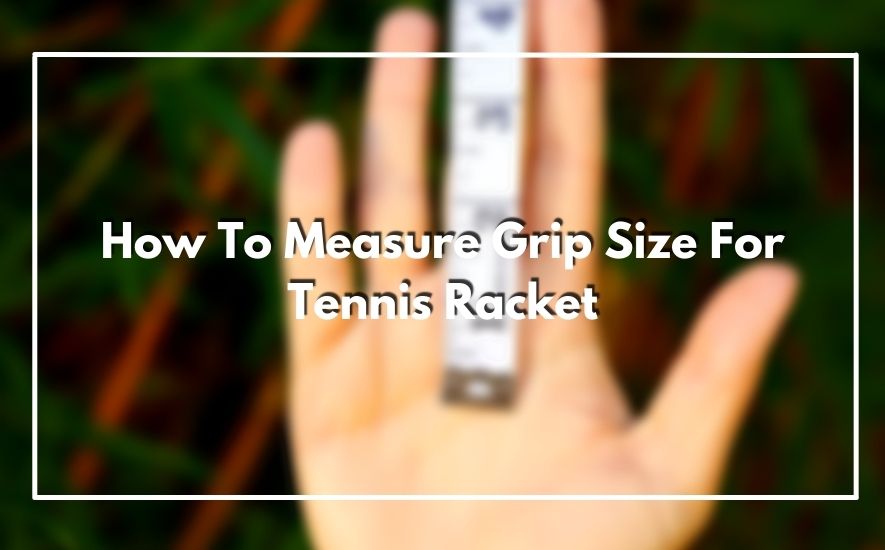Choosing the right grip size for your tennis racket is vital for enhancing your game performance and preventing injuries. The grip size directly impacts your ability to handle the racket comfortably and maintain control over your shots. A racket with an ill-fitted grip can lead to discomfort and diminished playing efficiency.
How To Measure Grip Size For Tennis Racket? To measure your tennis racket’s grip size, you’ll need a ruler or a grip-sizing tool. Place the ruler perpendicular to the racket’s handle and measure the distance from the top of the handle to the middle crease of your palm.
However, fear not, as determining the ideal grip size for your tennis racket is a straightforward process that ensures a seamless connection between your hand and the racket’s handle. In this article, we will walk you through the steps of accurately measuring your grip size, empowering you to make an informed decision that optimizes your playing experience on the court.
Table of Contents
How to Choose the Right Grip Size for Your Tennis Racket
Selecting the appropriate grip size for your tennis racket is crucial for optimizing your performance on the court. A proper grip ensures comfort, control, and prevents injuries. Here, we will guide you through the process of finding the ideal grip size that suits your hand and playing style.
Understand the Importance of Grip Size:
The grip size significantly influences your ability to execute shots accurately and comfortably. An ill-fitted grip may lead to inefficient strokes, discomfort, and potential injuries. Therefore, taking the time to find the right grip size is essential for enhancing your tennis experience.
Measure Your Hand Size:
To determine the right grip size, start by measuring your hand. Using a ruler or a grip-sizing tool, measure the distance from the lateral crease of your palm (where your hand meets your wrist) to the tip of your ring finger. Ensure that your fingers are stretched out, and the measurement is accurate. The result will help you identify the grip size that suits you best.
Understanding Grip Sizes:
Tennis racket grip sizes typically range from 4 inches to 4 7/8 inches. Each grip size affects how the racket feels in your hand, influencing your control and comfort levels. A smaller grip offers more control but may cause discomfort, while a larger grip provides comfort but may sacrifice some control. Choose wisely based on your hand size and playing preferences.
The Perfect Fit:
Ideally, your grip size should be one that allows you to comfortably hold the racket without having to squeeze too tightly. A proper grip should enable you to maintain a relaxed and natural grip throughout your game. A grip that is too small might lead to excessive wrist movement, while an oversized grip can strain your hand and forearm.
Consider Your Playing Style:
Your playing style also plays a role in determining the right grip size. If you are an aggressive player who hits powerful shots, a slightly smaller grip may enhance your control. On the other hand, a defensive player might benefit from a larger grip to aid in absorbing shock during rallies.
Test Different Grip Sizes:
Don’t hesitate to try out various grip sizes before making a final decision. Many tennis shops offer demo rackets with different grip sizes that you can use to get a feel for what suits you best. Take the opportunity to play a few shots with each size to assess comfort and performance.
Seek Expert Advice:
If you find it challenging to decide on the right grip size, consult a professional tennis coach or an experienced player. They can observe your grip and playing style, offering valuable insights and recommendations based on their expertise.
Replacing Grips vs. Overgrips:
Keep in mind that you can fine-tune your grip size by adding overgrips. Overgrips add extra cushioning and increase the grip size slightly. However, they should not be used as a substitute for the correct grip size. If you need a significantly different grip size, it’s best to replace the original grip with one that matches your needs.
Measuring and Determining the Correct Grip Size for Your Tennis Racket
Finding the right grip size for your tennis racket is crucial for enhancing your performance and preventing potential injuries. A proper grip size ensures that you have optimal control over the racket and allows you to play with comfort and confidence.
Importance of the Correct Grip Size
Before we dive into the process, it’s essential to understand why the correct grip size matters. A grip that is too small can lead to excessive wrist movement and may cause discomfort and strain. On the other hand, a grip that is too large can result in a lack of control and maneuverability. Therefore, finding the perfect grip size is the first step towards maximizing your potential on the court.
Step 1: Gather the Necessary Tools
To begin, gather the tools required for the measurement process. You’ll need a ruler or a grip size measuring tool, which you can find at most tennis specialty stores. Additionally, you’ll need access to your tennis racket(s) and a comfortable, flat surface to work on.
Step 2: Prepare the Racket
Lay your tennis racket on the flat surface, ensuring that the racket handle is easily accessible for measurement. Before measuring, make sure the grip is clean and free of any dirt or residue. A clean grip ensures accurate measurements.
Step 3: Positioning and Measuring
Hold the racket in your non-dominant hand with the butt cap facing upwards. Place the ruler or grip size measuring tool against the bottom edge of the butt cap, extending towards the throat of the racket. Use your dominant hand to measure the distance between the tip of your ring finger and the second lateral crease of your palm. This distance will provide you with your initial grip size measurement.
Step 4: Account for Overgrips
If you prefer using overgrips (thin grips that wrap around your existing grip), make sure to factor them into your measurement. Overgrips can add extra size to the handle, so if you plan to use one or more, measure your grip size with the overgrip(s) in place.
Step 5: Interpret the Measurement
Now that you have the measurement in millimeters or inches, it’s time to interpret the results. Grip sizes usually range from 4 inches (100 mm) to 4 5/8 inches (117 mm), with 4 3/8 inches (110 mm) being the standard size for most adult players. If the measurement falls between two grip sizes, it’s generally better to choose the smaller size for better control.
Step 6: Try Different Grips
It’s essential to test the grip size before finalizing your choice. Borrow or rent rackets with different grip sizes to see which one feels the most comfortable and natural in your hand. Remember, personal preference plays a vital role in determining the perfect grip size.
Step 7: Seek Professional Advice
If you are uncertain or struggling to find the right grip size, don’t hesitate to seek advice from a tennis coach or a professional racket stringer. They have experience in helping players find their ideal grip size based on individual playing styles and needs.
Common Types of Tennis Grip Styles and Techniques
Tennis, an exhilarating sport enjoyed by millions around the world, demands not only skill but also an understanding of different grip styles and techniques. Mastering these various grips can significantly impact a player’s performance, allowing them to execute precise shots and enhance their overall game.
Eastern Forehand Grip:
The Eastern Forehand Grip is the most basic and widely used grip in tennis. It involves placing the base knuckle of the index finger on the third bevel of the tennis racket handle, creating a handshake-like position.
This grip allows players to generate substantial power and topspin while maintaining excellent control. It is favored for forehand shots, as it enables players to hit with ample topspin, creating a trajectory that keeps the ball in the court with added consistency.
Continental Grip:
The Continental Grip is considered a versatile grip as it works well for various tennis shots, including serves, volleys, and overheads. To execute this grip, position the base knuckle of the index finger on the second bevel of the racket handle, making it slightly more towards the top. This grip facilitates more stability and control over the ball, making it easier for players to handle volleys and hit slice shots effectively.
Semi-Western Forehand Grip:
The Semi-Western Forehand Grip is a popular choice for players who prefer a modern and aggressive playing style. To achieve this grip, align the base knuckle of the index finger with the fourth bevel on the racket handle, tilting it slightly towards the top. With this grip, players can generate exceptional topspin, allowing the ball to bounce high and kick off the court, making it challenging for opponents to return.
Western Forehand Grip:
The Western Forehand Grip, known for its extreme topspin potential, is utilized by players who aim to maximize spin and power in their forehand shots. To adopt this grip, place the base knuckle of the index finger on the fifth bevel of the handle, substantially tilted towards the top. Although this grip may reduce control compared to others, it enables players to generate remarkable topspin, especially on clay courts, where the ball grips the surface more effectively.
Two-Handed Backhand Grip:
The Two-Handed Backhand Grip is used predominantly by players who prefer added stability and control while hitting backhand shots.
To employ this grip, place your dominant hand in an Eastern Forehand Grip and your non-dominant hand in a Continental Grip, effectively creating a bridge between the two hands. This grip provides better stability and allows players to execute powerful backhand shots with greater accuracy.
One-Handed Backhand Grip:
The One-Handed Backhand Grip is a classic style used by players who appreciate the finesse and elegance of single-handed backhand shots. To execute this grip, simply hold the racket with your dominant hand using the Continental Grip. This grip enables players to add more slice and variety to their backhand shots, although it may require more wrist strength and control.
Maintaining Your Tennis Racket Grip
A well-maintained tennis racket grip is crucial for optimal performance on the court. A comfortable and secure grip enhances control over your shots, reduces the risk of injuries, and allows you to play with confidence. By following these simple yet effective tips, you can prolong the life of your racket grip and elevate your game to new heights.
1. Choosing the Right Grip Size:
Selecting the appropriate grip size is the first step in maintaining your tennis racket grip. A grip that is too small or too large can lead to discomfort, hand fatigue, and diminished performance.
To determine the right grip size, hold the racket in your dominant hand with a semi-western grip, and ensure that you can comfortably fit your index finger between your palm and the tips of your fingers. If there’s no space or too much space left, consider adjusting the grip size accordingly.
2. Regular Cleaning and Hygiene:
Maintaining a clean grip not only ensures a better playing experience but also contributes to its longevity. Regularly clean your grip with a damp cloth to remove dirt, sweat, and oils that accumulate during play. Avoid using harsh chemicals or excessive water, as these can damage the grip’s material. Additionally, consider using an overgrip over your base grip to protect it further and extend its lifespan.
3. Rotation for Even Wear:
Frequently change the position of your grip to achieve even wear. Rotating the grip helps prevent specific areas from wearing out faster than others, ensuring consistent performance. Most players tend to wear out the grip’s upper portion, so rotating it periodically will help distribute the wear more evenly. It’s recommended to rotate the grip every few weeks, depending on how often you play.
4. Avoid Overgrip Build-up:
While overgrips are beneficial for sweat absorption and added cushioning, avoid layering them excessively. A thick overgrip can alter the grip size and feel, making it uncomfortable to hold. Instead, change the overgrip when it starts to lose its tackiness or becomes too worn out. This practice will maintain the desired feel and ensure a solid connection between your hand and the racket.
5. Store Rackets Properly:
Proper storage is essential to keep your racket grip in good condition. Avoid leaving your tennis racket in extreme temperatures, such as in a hot car or under direct sunlight, as it can cause the grip to degrade and lose its tackiness. Opt for a racket bag with temperature insulation features, and store your rackets in a cool, dry place to maintain their performance and durability.
6. Replace Worn-out Grips:
No matter how well you maintain your grip, it will eventually wear out with time and usage. Pay attention to signs of wear, such as cracks, peeling, or a significant loss of tackiness.
When you notice these signs, it’s time to replace the grip. Removing the old grip carefully and installing a new one following the manufacturer’s instructions will breathe new life into your racket and enhance your playing experience.
Conclusion
In conclusion, determining the appropriate grip size for your tennis racket is a vital aspect of optimizing your performance on the court. By following the straightforward methods outlined, such as using the index finger test, analyzing hand measurements, or consulting with a professional, you can easily find the perfect grip size tailored to your needs. A properly sized grip enhances comfort, reduces the risk of injury, and ensures a secure hold during intense gameplay.
Remember, investing time in this process will ultimately pay dividends, as it directly impacts your control, power, and overall enjoyment of the game. So, go ahead and put these techniques to the test, and let your improved grip size elevate your tennis prowess to new heights!



